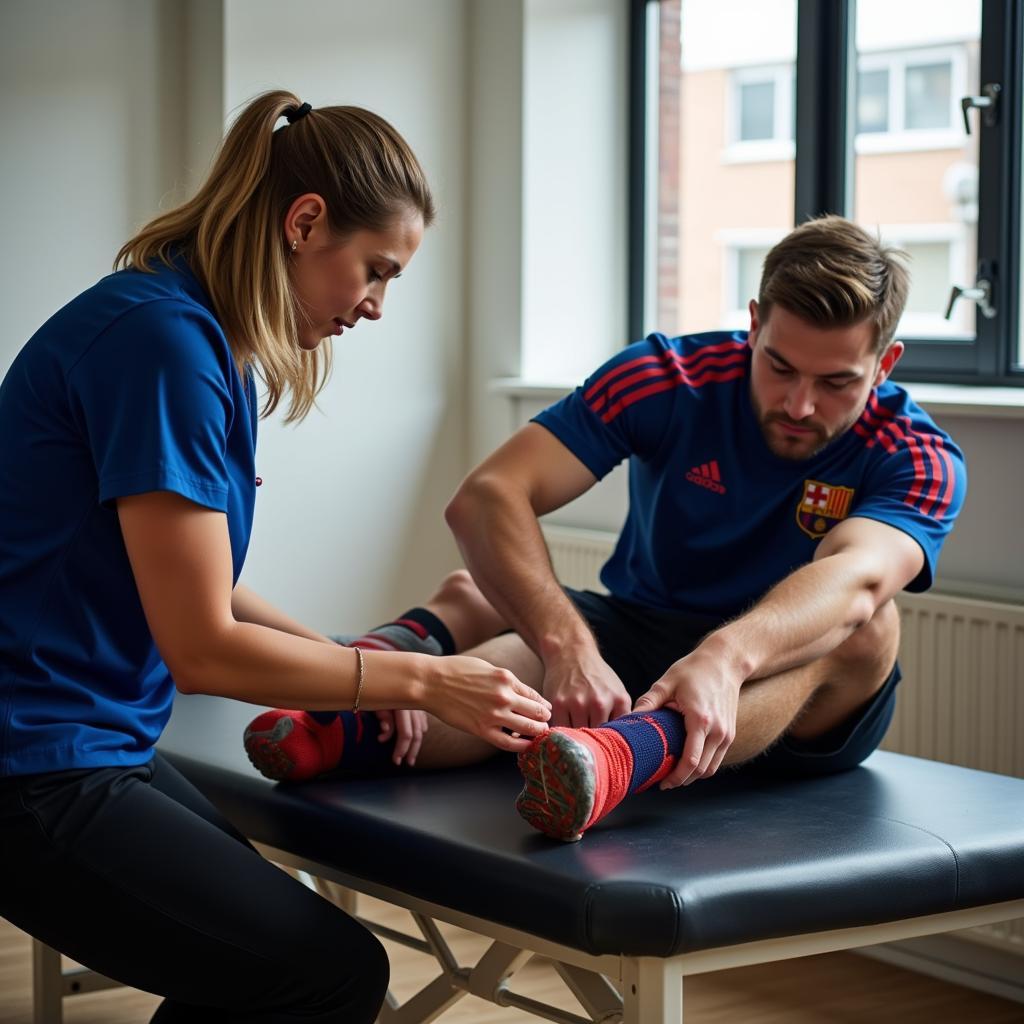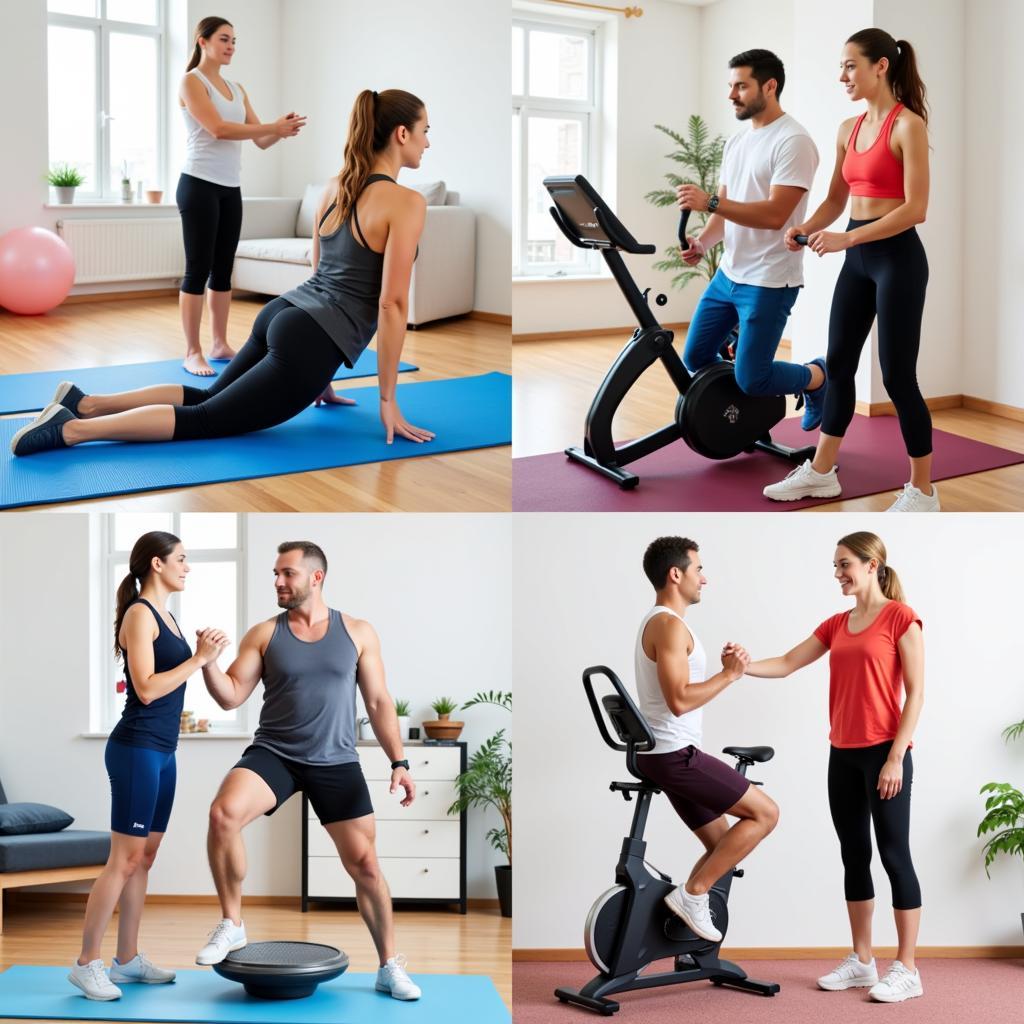How to Recover from a Sports Injury Like a Pro
October 18, 2024As a professional footballer, I know firsthand the frustration and disappointment that comes with a sports injury. It’s a setback that can sideline you for weeks, months, or even longer. But the road to recovery doesn’t have to be long and arduous. With the right approach, you can bounce back stronger than ever. Here’s how to navigate the recovery process effectively and get back in the game.
Understanding Your Injury: The First Step to Recovery
Before you can even think about treatment, it’s crucial to understand the nature and severity of your injury. This involves a proper diagnosis from a qualified medical professional. They will assess your injury, determine the extent of the damage, and recommend the best course of action.
 Sports Injury Diagnosis
Sports Injury Diagnosis
The Power of RICE: Your Immediate Action Plan
In the immediate aftermath of an injury, particularly acute injuries like sprains or strains, the RICE protocol is your best friend. RICE stands for Rest, Ice, Compression, and Elevation.
- Rest: Protect the injured area by avoiding activities that cause pain or discomfort.
- Ice: Apply ice packs for 15-20 minutes at a time, several times a day, to reduce swelling and pain.
- Compression: Use a compression bandage to help minimize swelling and provide support to the injured area.
- Elevation: Keep the injured area elevated above your heart level to further reduce swelling.
Fueling Your Recovery: Nutrition Matters
What you eat plays a crucial role in your body’s ability to heal and recover. Focus on a balanced diet rich in:
- Protein: Essential for tissue repair and rebuilding muscle mass. Lean meats, fish, beans, and lentils are excellent sources.
- Healthy Fats: Omega-3 fatty acids found in fatty fish, flaxseeds, and walnuts can help reduce inflammation.
- Vitamin C: This vitamin is crucial for collagen production, which is essential for tissue healing. Citrus fruits, berries, and bell peppers are good sources.
 Nutrition for Sports Injury Recovery
Nutrition for Sports Injury Recovery
The Road to Recovery: Physical Therapy and Rehabilitation
Physical therapy is a cornerstone of sports injury recovery. A qualified physical therapist will design a personalized program to:
- Reduce Pain and Swelling: Using modalities like ultrasound, electrical stimulation, or manual therapy.
- Restore Range of Motion: Gentle exercises and stretches help regain flexibility and mobility.
- Rebuild Strength and Endurance: Gradually increasing the intensity and difficulty of exercises to regain lost strength and endurance.
- Improve Balance and Coordination: Essential for preventing future injuries and regaining confidence in your movements.
Listening to Your Body: The Key to Long-Term Success
Remember, recovery is not a linear process. There will be good days and bad days. Pay attention to your body’s signals and communicate openly with your doctor or physical therapist about any pain or discomfort you experience.
“Pushing through pain” is a recipe for setbacks. It’s better to progress gradually and safely than to risk re-injury and prolong your recovery time.
 Physical Therapy for Sports Injuries
Physical Therapy for Sports Injuries
Mental Toughness: Staying Positive Throughout the Journey
Sports injuries can take a toll not only on your physical health but also on your mental well-being. It’s natural to experience frustration, discouragement, or even a sense of loss. Here are some tips to stay mentally strong:
- Set Realistic Goals: Break down your recovery into smaller, manageable milestones. Celebrate each achievement along the way.
- Stay Connected: Surround yourself with supportive friends, family, and teammates. Don’t hesitate to reach out for help or encouragement when you need it.
- Focus on What You Can Control: Instead of dwelling on what you can’t do, focus on your rehabilitation program and maintaining a positive mindset.
- Visualize Success: Imagine yourself returning to your sport stronger and more resilient than before. Visualization can be a powerful tool for motivation.
Conclusion: Your Comeback Starts Now
Recovering from a sports injury requires patience, dedication, and a commitment to the process. By following these tips, working closely with your healthcare team, and listening to your body, you can overcome this challenge and return to doing what you love. Remember, setbacks are a part of life, but they don’t have to define your journey. Your comeback starts now.
FAQ
Q: How long does it take to recover from a sports injury?
A: Recovery time varies greatly depending on the type and severity of the injury. It can range from a few weeks for minor sprains to several months for more serious injuries like ligament tears or fractures.
Q: When can I return to playing sports after an injury?
A: It’s crucial to follow your doctor or physical therapist’s guidance regarding returning to sports. They will assess your progress and give you the green light when you’ve regained sufficient strength, flexibility, and stability to participate safely without risking re-injury.
Q: How can I prevent future sports injuries?
A: Some key strategies include:
- Proper Warm-up: Always warm up adequately before any physical activity to prepare your muscles and joints for the demands of your sport.
- Strength Training: Incorporate regular strength training exercises to build strong muscles, which can help protect your joints and reduce your risk of injury.
- Flexibility and Balance: Don’t neglect flexibility and balance exercises. These are essential for maintaining optimal range of motion and stability, which can help prevent awkward movements that can lead to injuries.
- Listen to Your Body: Don’t push through pain. Rest when you need it and allow your body adequate time to recover after strenuous activity.
Q: What are some common mistakes people make during sports injury recovery?
A:
- Returning to activity too soon: This is one of the most common mistakes that can lead to re-injury and prolong the recovery process.
- Ignoring pain signals: Pushing through pain can worsen your injury. It’s crucial to listen to your body and communicate any discomfort to your healthcare provider.
- Neglecting other aspects of recovery: Focusing solely on physical therapy and neglecting nutrition, sleep, and stress management can hinder your progress.
Q: When should I see a doctor for a sports injury?
A: It’s generally advisable to seek medical attention if you experience:
- Severe pain that limits your ability to move the injured area
- Sudden swelling or bruising
- Numbness or tingling
- A popping or snapping sound at the time of injury
- Difficulty bearing weight on the injured limb
If you have any concerns about a sports injury, it’s always best to err on the side of caution and consult with a healthcare professional.
Need more information or support on your road to recovery? Don’t hesitate to reach out to our team. Contact us at:
Phone: 0396443476
Email: [email protected]
Address: 23 Tháng 3, Đắk Nia, Gia Nghĩa, Đắk Nông, Vietnam.
We’re here to help you get back in the game!